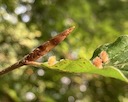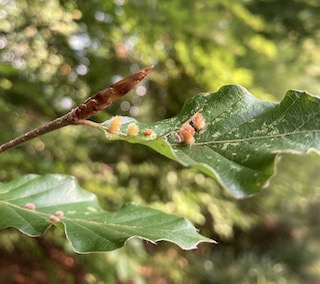 In late summer into autumn, you may see small cylindrical growths on Beech leaves. These are made by the gall midge Hartigiola annulipes. Look out for them when exploring the woods of the Helford River.
In late summer into autumn, you may see small cylindrical growths on Beech leaves. These are made by the gall midge Hartigiola annulipes. Look out for them when exploring the woods of the Helford River.
Photo: Amanda Scott
Scientific name: Hartigiola annulipes (this is the name of the parasitic gall-midge that induces the galls)
What to look for:
• Appearance: Hairy Beech Galls are tiny (≤5 mm high) and cylindrical when mature. Yellowish green when first formed, they darken to a reddish brown by the autumn, and have a more or less hairy appearance.
• Where: On Beech trees.
• When: The galls initially appear as a circular greenish dome in the spring that can be seen on the leaf’s upper- and underside. They develop into the cylindrical structure on the upperside by autumn.
 Have you ever wondered about those small knobbly discs or protuberances sticking to the leaves of trees, especially visible in the autumn? More often than not these are galls, of which there are over 1,000 kinds in the UK alone. They form as the result of another organism, such as a gall wasp or mite, for example, living on (sometimes in) the host plant and creating food and shelter for itself by inducing the host’s cells to grow in size or number. They are therefore parasitic, but generally cause little if any long-term damage.
Have you ever wondered about those small knobbly discs or protuberances sticking to the leaves of trees, especially visible in the autumn? More often than not these are galls, of which there are over 1,000 kinds in the UK alone. They form as the result of another organism, such as a gall wasp or mite, for example, living on (sometimes in) the host plant and creating food and shelter for itself by inducing the host’s cells to grow in size or number. They are therefore parasitic, but generally cause little if any long-term damage.
One common gall found on Beech trees (Fagus sylvatica) is the Hairy Beech Gall, induced by the gall midge Hartigiola annulipes. The midges lay their eggs in the Beech leaves in the spring, after which each larva induces a circular, raised, yellow-green growth that can be seen on both sides of the leaf. By autumn, the gall has become reddish brown and elongated on the upper side of the leaf. Some but not all of the galls have a pointed tip, and not all have the same amount of hair. The gall eventually falls from the leaf, and the larva pupates on the ground, remaining inside the gall. The midges emerge in spring, and so the cycle continues.
 Trees are not generally adversely affected by the presence of galls. In mast years (years when an abundance of seeds are produced, especially by Beech and Oak), the trees put most of their energy into fruiting, so they may be more susceptible to infestation. Generally, however, they recover well in the next year.
Trees are not generally adversely affected by the presence of galls. In mast years (years when an abundance of seeds are produced, especially by Beech and Oak), the trees put most of their energy into fruiting, so they may be more susceptible to infestation. Generally, however, they recover well in the next year.
Did you know…?
…The name for someone who studies galls is a cecidologist.
More information and references:
Chinery, M., 2011. Britain’s Plant Galls. A Photographic Guide. WildGuides Ltd., Hampshire.
Published: September 2020
Author: Amanda Scott
Photos: Amanda Scott
